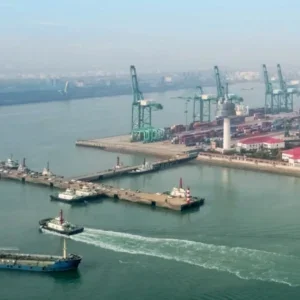For Vetter, the 1990s was a decade of rapid development. For 40 years the Vetter name has been known in the European hoist industry for slewing jib cranes but in the last decade turnover has tripled, a success partly attributed to an investment of more than DM4m ($2m) in modernising the slewing crane production facilities. The main factory in Germany uses the latest production technology with automated machines that quickly and accurately make components such as the columns and jibs. These components are turned into an annual output of thousands of slewing jib cranes.
All very different from the company’s early days. Vetter was founded in 1889 as a small smithy, manufacturing products for the regional mining industry. Over many years the company developed into a well-established supplier of material handling machines for the European mining industry, particularly mine cars and cages. With the fall of the European mining industry at the beginning of the 1960s Vetter started to restructure the company and began to build column- and wall-mounted slewing jib cranes. And the smithy was used to manufacture forks for lift trucks.
Since 1960 the specialisation in these two products has brought rapid development to the family-owned company. Today Vetter, with 250 employees and an annual turnover of more than DM60m ($30m), has three divisions: Vetter Fördertechnik GmbH where slewing cranes and Rotomax load turning devices are built; Vetter Kranservice GmbH for crane servicing; and Vetter Umformtechnik GmbH where forks for lift trucks are made.
Responsible for the crane side of the business is Klaus Vetter, managing director since 1962. Cranes are produced at the factory in Siegen, about 80km east of Köln, and at a subsidiary in Magdeburg near Berlin. Arnold Vetter, Klaus’s son, is the managing director of Vetter Umformtechnik, Burbach, near Siegen, where the forks are made.
In both product fields, slewing cranes and forks for lift trucks, Vetter is a leading European manufacturer. More than 3,000 slewing cranes and more than 200,000 forks are produced annually.
In recent years more than DM4m has been invested in the modernisation of slewing crane production, and more than DM10m in fork production facilities. Since 1990 the turnover of the Vetter company has tripled from DM20m to more than DM60m. Klaus and Arnold Vetter put down the success to market strategy and specialisation, coupled with a high standard of quality.
Research and development are given high priority. Vetter has close links with the University of Siegen in the field of product optimisation and production technology. Since 1995 all Vetter companies have been certified according to ISO 9001 by Lloyd’s Register.
Modern production facilities at the old main factory in Siegen, where cranes and the Rotomax load turning devices are made, include a clear division between the production lines for columns and jibs. Before the raw material enters the production process, it is shot-blasted clean which helps to keep the whole of the ensuing production process clean.
“Our quality assurance starts with the incoming inspection,” says Klaus Vetter. “We exclusively use certificated material.” Jib and column sections are made on automated cutting machines and all further steps use tooling that includes clamping devices and jigs. A robot, recently installed, welds the foot plates, top plates and pressure rings.
A look around the workshop reveals the large quantities and the variety of different types of small and large slewing crane. In addition to standard cranes with capacities from 125kg to 10,000kg, special, large cranes with higher capacities and outreaches are produced. A recent large order was for ship-mounted cranes that can operate even when the ship is heeling 7°.
Non-standard column- and wall-mounted slewing cranes can be made in an almost infinite number of combinations of capacities from 125kg to 20,000kg and jib lengths between 2m and 20m. Most of the smaller cranes are manually operated and the larger cranes, above 1,000kg capacity, have electrical slewing and hoist drives. Special cranes of nearly all sizes with capacities up to 100t are not unusual. Vetter recently delivered an 80t capacity boat harbour crane with a 12m jib.
The secret of the variety of standard crane types is in the standardisation of almost all components. Basically there are only seven jib types and seven column diameters. The standard components can be produced in large quantities. On the company’s website customers can make use of a crane configuration program to help them find a suitable crane for their specific application.
Vetter supplies the hoist industry throughout Europe with products made to DIN 15018 and European Standards. In addition to production at the Vetter factories in Germany there are licensed partners that produce Vetter designs in France, Canada and Australia.
Not all of the company’s cranes appear on the market bearing the Vetter brand name. A multi-branding strategy is employed, where the product itself, a slewing crane, for example, is being sold rather than the Vetter brand.
Aside from slewing jib cranes Vetter also offers the Rotomax load turning device for turning awkward loads. The company has a leading position in the European market for these products. A recent delivery was an 80t version for rotating marine diesel engines. Altogether several thousand load rotators have been sold worldwide. Available are standard models from 3t to 20t capacity and specially designed ones with capacities up to 100t.
Klaus Vetter clearly expects the company to keep growing. He says: “Due to our very modern production facilities and the constantly excellent quality we expect to win more market share within Europe and thereby to raise the production quantities not only in the field of slewing cranes but also in the field of forks for fork lift trucks. The current export rate is already 30% for slewing cranes and more than 40% for forks.”






